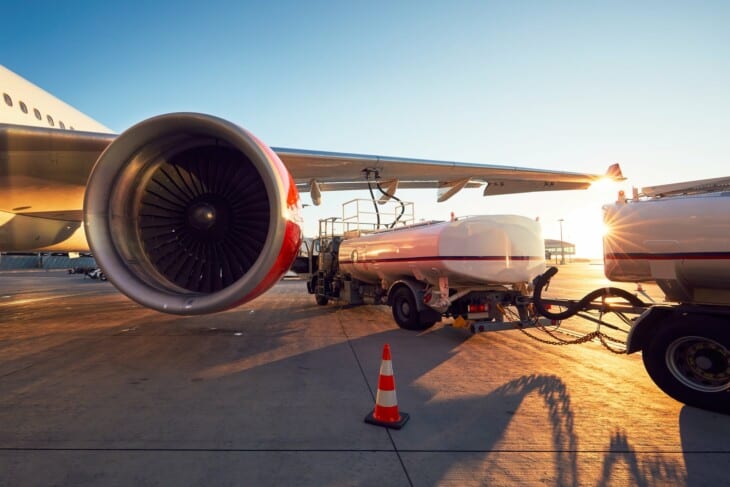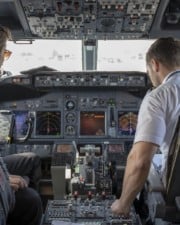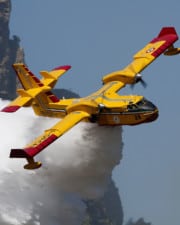In the world of aviation fuels, kerosene and avgas are the two most famous. Though they are both similar in many ways, pilots need to be aware of their key differences if they want to operate their aircraft safely and efficiently. So what’s the difference?
The key difference between kerosene and avgas is their formulation. Kerosene is a long chain hydrocarbon whilst avgas is a short chain hydrocarbon, making them better for different types of applications. This is why kerosene is typically used in jets, whilst avgas powers piston aircraft.
What is Kerosene?
Arguably the most famous type of aviation fuel, kerosene is derived from crude oil. It is a long chain hydrocarbon that is incredibly energy dense with high freezing and flash points, making it perfect for high altitude use, such as in aviation.
Whilst kerosene’s most famous use is as an aviation fuel, it is a catch-all term that also encompasses several non-aviation fuels which are often used in lighting, cooking, cleaning and agriculture.
Kerosene was discovered in 1854 by Canadian scientist and geologist Abraham Gesner, who immediately recognized its use as a fuel, particularly in lamps for lighting.
Its use as an aviation fuel didn’t happen until nearly 100 years after its discovery, during WWII, when aircraft engineers on both sides raced to produce jet engines to put in aircraft that would give their nations the upper hand in the war.
As jets were introduced on a wide scale after the war’s end – for both military and commercial use – kerosene-based aviation fuels became widespread in a variety of formulations.
Today, the most common kerosenes in commercial aviation are Jet A and Jet A-1, whilst the most common kerosene in military aviation is JP-8. Kerosene aviation fuels, sometimes known as aviation turbine fuels, are primarily used to power jets and turboprops.
What is Avgas?
Much like kerosene, avgas too is derived from crude oil, though is from a much higher position in the fractionating tower, forming a short chain hydrocarbon with a high octane rating.
Avgas was first formulated during the pioneer era of aviation, at a time when most aircraft engines ran on the same fuels as automobile engines, as a way of increasing the performance of those engines at high altitudes.
The avgas formulations that are used today were first formulated in the 1940s, when a standardized avgas formulation was needed due to the demands of WWII, as dozens of aircraft that would overwise use different formulations were all based at the same airstrips.
The most popular avgas formulations today are Avgas 100 and 100LL. The number designation “100” refers to the octane number (in this case 100; typical car gasoline is 95 octane), itself an indication of how resistant to engine knocking the fuel is.
Avgas is the most common type of fuel used for piston aircraft, ranging from small GA aircraft like the Cessna 152 all the way up to large pistons like the Boeing 377.
Currently, over 20 formulations of avgas exist; each with their own octane number, color, lead content, additives and uses.
How Are Kerosene and Avgas Different?
From a chemical perspective, kerosene falls in the C10-16 hydrocarbon range (10-16 carbon atoms per molecule), whilst avgas tends to fall in the C4-12 range (4-12 carbon atoms per molecule).
Because of this, kerosene and avgas have different energy contents, with kerosene having an energy content of approximately 35.8 – 36.9 MJ/L (135,000 – 140,000 BTU/gal) whilst avgas has an energy content of approximately 31.7 – 33.0 MJ/L (120,000 – 125,000 BTU/gal).
This means that kerosene is more energy dense than avgas, allowing kerosene-powered aircraft to have better performance than avgas-powered aircraft.

Although controversial, and something the industry is trying to move away from, avgas has a lead additive to increase lubrication when used in aircraft engines.
Kerosene, on the other hand, does not have any lead additives, and indeed, lead contamination can seriously damage aircraft engines designed to be powered by kerosene.
Kerosene has a lower freezing point than avgas, at roughly -47°C to -50°C (-53°F to -58°F) compared to avgas’s -40°C (-40°F), which makes kerosene better for high altitude flying where the air is thinner and colder.
Due to all this, the key difference between kerosene and avgas is their use. Kerosene typically powers high performance jet and turboprop aircraft, whilst avgas instead powers piston aircraft.
How Are Kerosene and Avgas Similar?
The key similarity between kerosene and avgas is that they are both derived from crude oil, as are the many other types of aviation fuels.
Being both derived from crude oil, both avgas and kerosene are some of the most energy dense fuels known to man, which is why they are both used to power aircraft.
Similarly, how both fuels are handled are almost identical. As both are liquids at room temperature, they must be stored in tanks. These tanks are identical in terms of size, construction etc. though are obviously separate to prevent cross-contamination.
Indeed, many manufacturers of avgas storage tanks also have their own lines of kerosene storage tanks (marketed under different names or colors for differentiation) for this purpose.
What’s Better About Kerosene?
Due to kerosene having a higher flash point (the lowest temperature required for a fuel to ignite) than avgas, kerosene is less flammable than avgas. Because of this, it can be argued that at least in that regard, kerosene is safer than avgas.
Similarly, kerosene is also more energy-dense than avgas, making it considerably more fuel efficient per gallon/liter of fuel than avgas.
Though kerosene-powered engines are seen as higher tech, they are actually easier to maintain due to a lower number of moving parts (and thus things to go wrong), reducing maintenance costs for kerosene powered aircraft relative to avgas-powered aircraft.
In recent years, there has been a huge push to make the aviation industry more “green” leading to the introduction of green aviation fuels commonly known as “sustainable aviation fuel (SAF)”.
These SAFs are meant to be green alternatives for kerosene-based aviation fuels, to reduce their carbon emissions. Avgas, on the other hand, has yet to see any green alternatives enter testing, production or use.
What’s Better About Avgas?
If we’re talking about popularity, the clear winner is avgas. There are almost six times as many avgas-powered aircraft in the US as there are kerosene-powered ones, and this is likewise reflected across the rest of the world.
Due to this, avgas is far more readily available; while kerosene is generally only found at large and midsize airports, avgas can be found at small, medium and indeed many large airports too, expanding operators of avgas-powered aircraft choice when it comes to airstrips to land at, as they don’t have to worry about not being able to refuel.
As a result, there are far more manufacturers of avgas than there are for kerosene, many of which are local enterprises and produced domestically, meaning that in much of the rest of the world, avgas is cheaper per liter than kerosene is.
Conclusion
Though both avgas and kerosene are derived from the same thing: crude oil, and are used to power aircraft, both fuel types are inherently different.
Kerosene is a long form hydrocarbon, whilst avgas is a short form hydrocarbon. Kerosene has a higher energy density and is typically used to power jets and turboprops, whilst avgas is less energy dense and used to power piston aircraft.
Neither kerosene nor avgas can be used as a substitute for one another without major changes to the aircraft’s engine, less you’ll destroy your aircraft’s engine(s).
For aircraft engineers, the choice of whether to power their aircraft with kerosene or avgas is down to the powerplant(s) they choose, which are in turn driven by the flight characteristics and specs that are desired.
Related Posts














